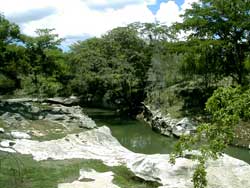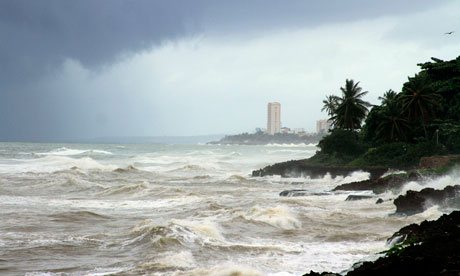Par Ayiti Kale Je
Près de quatre-vingt mille minuscules maisons jonchent les collines de la capitale haïtienne et d’autres régions dévastées par le séisme du 12 janvier 2010, qui a emporté 230 000 âmes, endommagé ou détruit 171 584 maisons et déplacé des millions de personnes.
La Commission Intérimaire pour la Reconstruction d'Haïti (CIRH), dirigée par Bill Clinton, a approuvé des budgets totalisant 254,5 M$ pour des projets de reconstruction, de rénovation et de réparation de plus de 41 700 unités d’habitation.
Le nouveau gouvernement haïtien, dirigé par le chanteur Michel Joseph Martelly, a récemment organisé la « semaine de la reconstruction ». Parmi les activités, M. Clinton et le Président ont inauguré une « exposition de domiciles » avec plus de 60 maisons modèles et un nouveau programme hypothécaire appelé « Kay Pa M », en français « Ma maison ».

Peut-on insinuer que la reconstruction a bien commencée? Les 634 000 personnes vivant encore dans les 1001 camps, comme les autres dizaines de milliers vivant dans des structures peu sécuritaires, voire condamnées, pourront-ils bientôt déménager dans un domicile sécuritaire?
Ayiti Kale Je a décidé d’y regarder de plus près. Son équipe de journalistes des radios commautaires, d’étudiants et de journalistes ont parlé à ceux qui vivent dans les camps, aux organisations humanitaires et aux autorités de la capitale, de la région des Palmes en particulier, soit les municipalités de Léogâne, Petit-Goâve et Grand Goâve, situés près de l’épicentre du tremblement de terre, où 150 000 personnes se sont retrouvées sans maison et où s’entassent encore environ 24 000 personnes, ou 7500 familles, dans des camps.
Dix-sept mois après le séisme, voici ce qu’ils ont trouvé :
• Les travaux de réparation et de construction de 68 025 unités qui seront effectués ne compte que pour environ 22 pour cent (22%) des 304 060 familles victimes enregistrées. (De nos jours, la population dans les camps a diminué, ce en raison de divers facteurs, dont les expulsions de plus de 50 000 personnes, ainsi que le retour de milliers de familles dans des logements dangereux.)
• La plupart des programmes et des projets annoncés à ce jour excluent les centaines de milliers de victimes qui étaient locataires avant le séisme.
• Au moins 5 400 des unités qui seront construites ou réparées sont dans le département du Nord d’Haïti, loin de l’épicentre du séisme et de ses victimes, mais tout près de la zone où les compagnies étrangères prévoient un nouveau parc industriel d’usines de montage à faibles salaires.
• Les propriétaires terriens et du bâtis sont les principaux groupes bénéficiaires des 116 000 T-Shelters (abris « transitionnels » ou « temporaires »), qui coûtent plus de 200 M$ US aux agences humanitaires et à leurs donateurs. Cependant, sur les 304 020 familles déplacées, plus de la moitié – soit environ 173 000 – n'avaient pas une maison ou un terrain avant le séisme.
• La plupart des camps de la région des Palmes, et d’ailleurs du pays, manquent d’installations hydriques et sanitaires adéquates. Les gens se baignent souvent, voire se soulagent, à ciel ouvert, utilisent de l’eau non chlorée, manquent d’installations où se laver les mains et vivent dans des conditions sordides et sous-humaines, dans un pays où, tous les jours, des centaines de personnes contractent le Vibrio cholerae.
• Aucune agence – nationale ou internationale – ne sert d’instance coordonnatrice pour la reconstruction de maisons, bien qu’on semble enfin voir des progrès en ce sens.
Par contre :
• Beaucoup des 116 000 T-Shelters peuvent se classer comme « semi-permanents » ou mieux, car ils sont construits de matériaux résistants sur des fondations solides, qui peuvent être renforcés ou agrandis.
• Les projets de reconstructions dans la capitale, qui sont évalués à plusieurs millions de dollars américains, promettent de réhabiliter des quartiers où vivent au moins 80 000 familles.
Louise Delva, d'un camp au Petit-Goave, indiquant ou elle et les autres residents du camp vont aux toilettes
Près de quatre-vingt mille minuscules maisons jonchent les collines de la capitale haïtienne et d’autres régions dévastées par le séisme du 12 janvier 2010, qui a emporté 230 000 âmes, endommagé ou détruit 171 584 maisons et déplacé des millions de personnes.
La Commission Intérimaire pour la Reconstruction d'Haïti (CIRH), dirigée par Bill Clinton, a approuvé des budgets totalisant 254,5 M$ pour des projets de reconstruction, de rénovation et de réparation de plus de 41 700 unités d’habitation.
Le nouveau gouvernement haïtien, dirigé par le chanteur Michel Joseph Martelly, a récemment organisé la « semaine de la reconstruction ». Parmi les activités, M. Clinton et le Président ont inauguré une « exposition de domiciles » avec plus de 60 maisons modèles et un nouveau programme hypothécaire appelé « Kay Pa M », en français « Ma maison ».

Stratégie annoncée par les agences internationales et le gouvernement en novembre dernier. A-t-il ete suivi? Source: Shelter Cluster
Ayiti Kale Je a décidé d’y regarder de plus près. Son équipe de journalistes des radios commautaires, d’étudiants et de journalistes ont parlé à ceux qui vivent dans les camps, aux organisations humanitaires et aux autorités de la capitale, de la région des Palmes en particulier, soit les municipalités de Léogâne, Petit-Goâve et Grand Goâve, situés près de l’épicentre du tremblement de terre, où 150 000 personnes se sont retrouvées sans maison et où s’entassent encore environ 24 000 personnes, ou 7500 familles, dans des camps.
Dix-sept mois après le séisme, voici ce qu’ils ont trouvé :
• Les travaux de réparation et de construction de 68 025 unités qui seront effectués ne compte que pour environ 22 pour cent (22%) des 304 060 familles victimes enregistrées. (De nos jours, la population dans les camps a diminué, ce en raison de divers facteurs, dont les expulsions de plus de 50 000 personnes, ainsi que le retour de milliers de familles dans des logements dangereux.)
• La plupart des programmes et des projets annoncés à ce jour excluent les centaines de milliers de victimes qui étaient locataires avant le séisme.
• Au moins 5 400 des unités qui seront construites ou réparées sont dans le département du Nord d’Haïti, loin de l’épicentre du séisme et de ses victimes, mais tout près de la zone où les compagnies étrangères prévoient un nouveau parc industriel d’usines de montage à faibles salaires.
• Les propriétaires terriens et du bâtis sont les principaux groupes bénéficiaires des 116 000 T-Shelters (abris « transitionnels » ou « temporaires »), qui coûtent plus de 200 M$ US aux agences humanitaires et à leurs donateurs. Cependant, sur les 304 020 familles déplacées, plus de la moitié – soit environ 173 000 – n'avaient pas une maison ou un terrain avant le séisme.
• La plupart des camps de la région des Palmes, et d’ailleurs du pays, manquent d’installations hydriques et sanitaires adéquates. Les gens se baignent souvent, voire se soulagent, à ciel ouvert, utilisent de l’eau non chlorée, manquent d’installations où se laver les mains et vivent dans des conditions sordides et sous-humaines, dans un pays où, tous les jours, des centaines de personnes contractent le Vibrio cholerae.
• Aucune agence – nationale ou internationale – ne sert d’instance coordonnatrice pour la reconstruction de maisons, bien qu’on semble enfin voir des progrès en ce sens.
Par contre :
• Beaucoup des 116 000 T-Shelters peuvent se classer comme « semi-permanents » ou mieux, car ils sont construits de matériaux résistants sur des fondations solides, qui peuvent être renforcés ou agrandis.
• Les projets de reconstructions dans la capitale, qui sont évalués à plusieurs millions de dollars américains, promettent de réhabiliter des quartiers où vivent au moins 80 000 familles.
Louise Delva, d'un camp au Petit-Goave, indiquant ou elle et les autres residents du camp vont aux toilettes
Louise Delva qui n'a pas obtenu un T-Shelter et qui ne fait pas partie des projets de reconstruction vit dans une tente pourie dans le camp "Regal" avec ses enfants pres d'une riviere que les refugies utilisent comme latrine. Pendant une semaine en juin, 21 des residents des camps ont ete frappes par le cholera. Elle se dit oubliee: "Ils disent que nous avons des dirigeants. Nous n'avons pas de dirigeants dans ce pays. Ils nous ont abandonne comme un chien errant"
Regardez le video avec visite aux trois camps




 The Haitian, Cuban and Dominican Environment Ministers agreed in 2007 to create a Biological Corridor in the Caribbean to face climate change, which is affecting the whole region, but mostly the Haitian nation.
The Haitian, Cuban and Dominican Environment Ministers agreed in 2007 to create a Biological Corridor in the Caribbean to face climate change, which is affecting the whole region, but mostly the Haitian nation. 